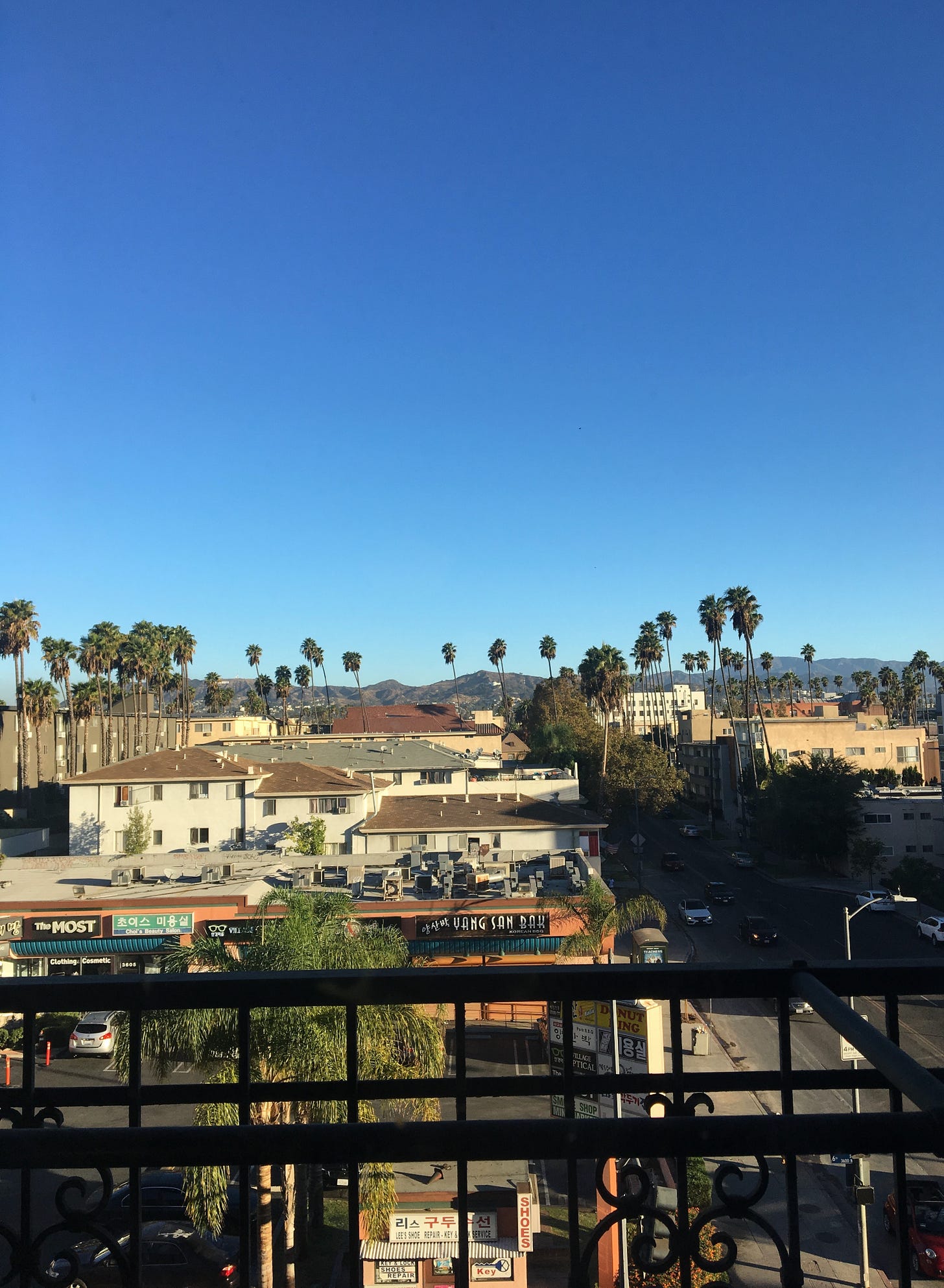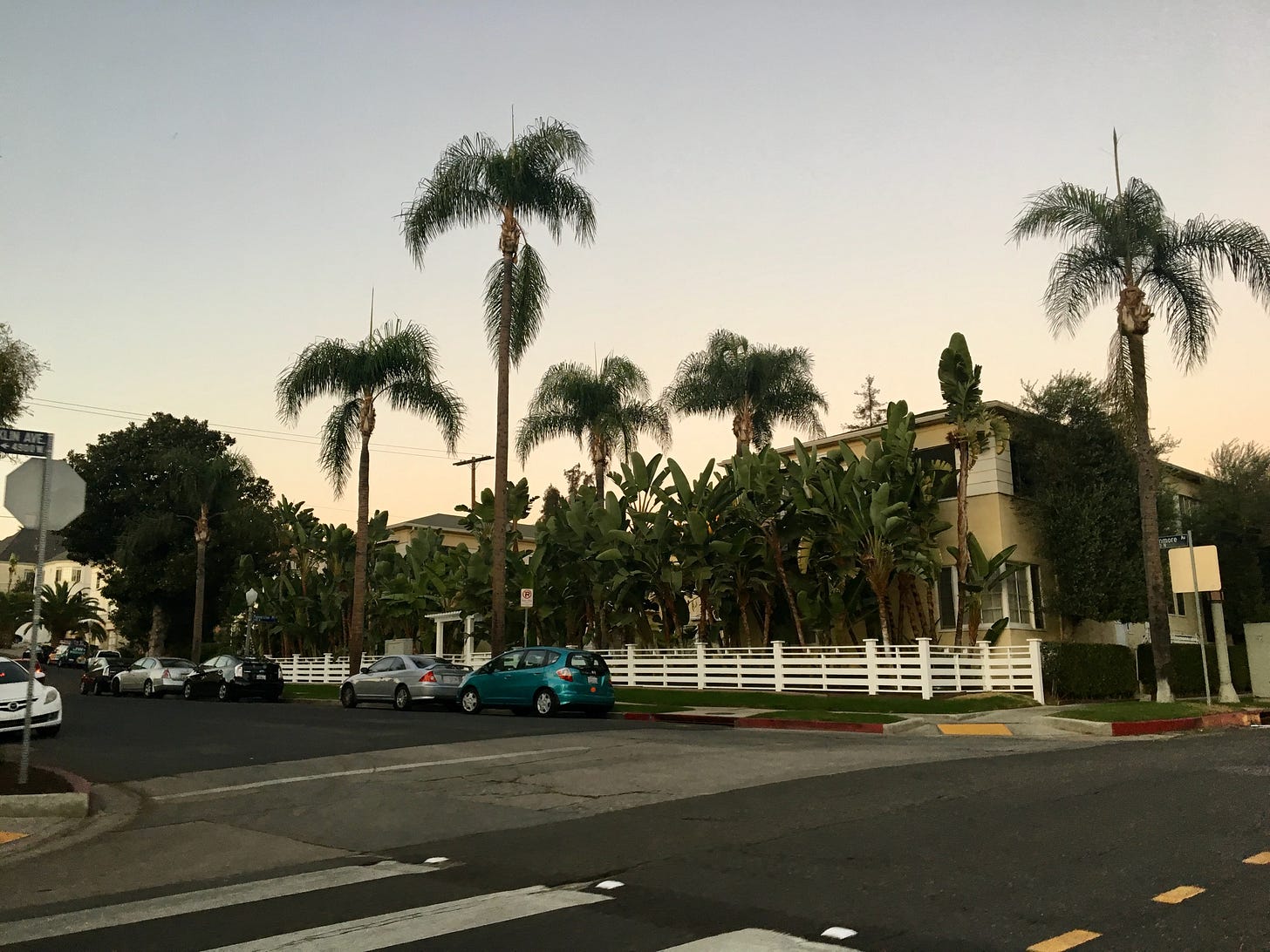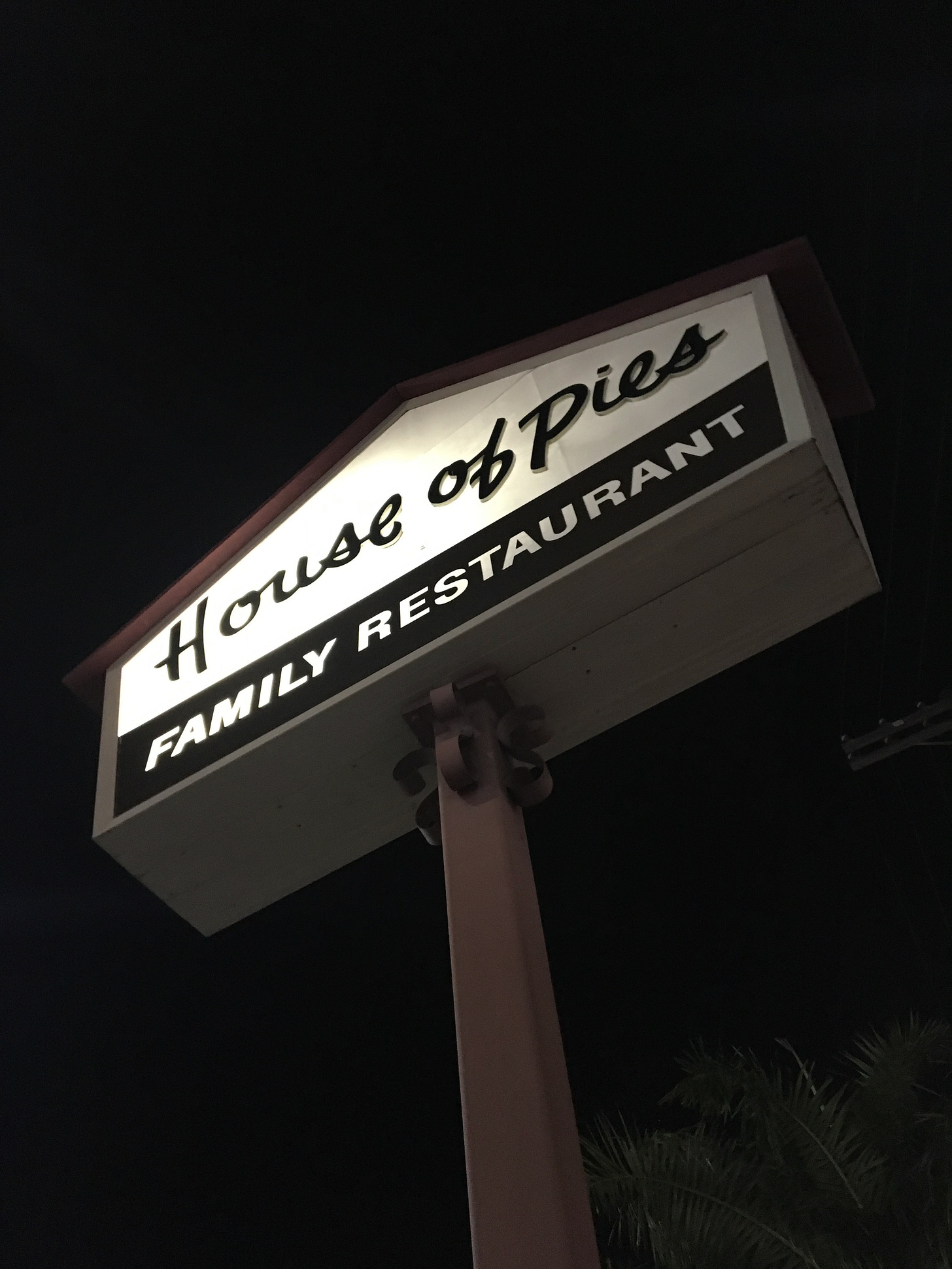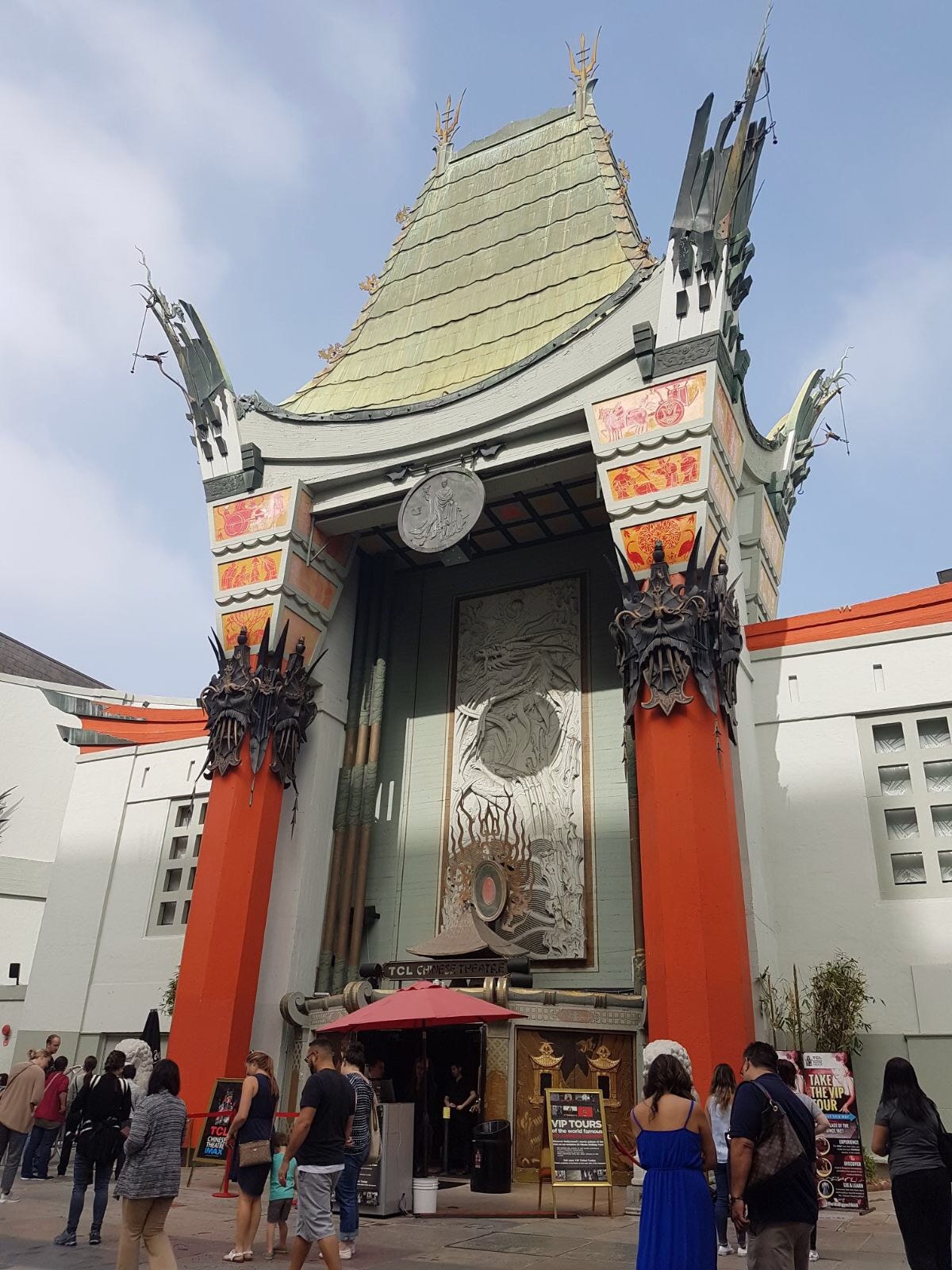I’ve been playing Bad Religion’s ‘Los Angeles is Burning’ on repeat for the past few weeks. I don’t think I have to explain why.
Tig’s getting good at understanding and finding meanings in song lyrics. When that song played in the car yesterday, she said, ‘I think he’s singing about how he’s sad that Los Angeles is burning because he loves Los Angeles. Just like you do.’ I started crying. Kids say the darnedest things.
Tig and Felix have never been to Los Angeles. The last time I was there was in 2017, before either of them were born. But evidently, I talk about it enough that she already knows it’s a special place to me.
The soundtrack to my life in LA was mostly a mix of ska, ‘global indie clubpop,’ movie scores and TV theme songs, and what might be broadly categorized as west coast jazz. This included the softer, sadder 1950s sounds of Julie London, Chet Baker and Stan Getz, as well as the 60s bossa nova bombast of Sergio Mendes, Quincy Jones, and Lalo Schifrin. Some of this stuff could be derisively described as elevator music, and it occasionally overlapped with exotica: the atmospheric but decidedly goofy Adventureland-via-Tomorrowland compositions of artists like Arthur Lyman, Martin Denny, and Juan García Esquivel. Many of my all-time favorite jazz tracks were performed by the vibraphonist Cal Tjader, and they could easily fit into this genre, with titles that directly reference locations in East and Southeast Asia: China Nights, Borneo, Leyte, Tokyo Blues.
Subconsciously – and maybe kind of consciously – I was curating a soundscape that suited LA as I saw it, like a synaesthetic painting by Oskar Fischinger. Music that conveyed pulsing pastel stucco solar-powered energy, or bronze and turquoise poolside show business romance. Taco trucks, Little Tokyo, Giant Robot. Shag, smog, the Dresden, the Dome. Los Angeles was beautiful, Los Angeles was weird, Los Angeles was scary. Coming from Wisconsin, or maybe from anywhere else in the world, Los Angeles was exotic. Landing at LAX for the first time was like landing on another planet. I didn’t know the sky could be that color. I didn’t know roads could have so many lanes. Hell, I had never even seen mountains before. This was somewhere different. Goodbye, Wisconsin. There was no turning back.
Jenny Lau – the great Celestial Peach – wrote a book! It’s called An A to Z of Chinese Food, but really, the food itself is just a springboard, a launchpad from which she blasts off into more interesting, more outré areas of thought, far beyond the usual “recipes and stories.” There’s a topic for each letter of the alphabet: “A is for Authentic,” “Z is for Zongzi,” and everything in between. E is for Exotic.
Lau’s focus in this chapter is the conflation of the exotic and the erotic, particularly as it applies to Asian women in the Western imagination. Let me say at this point that Lau is such a good writer that I feel both privileged and embarrassed to exist in the same universe as her. She has a way of locating nodes on the cultural circuit board that may seem distant to one another, but then finds ways to connect them and light them up through fluid, seamless writing that would seem like a breezy stream-of-consciousness if it wasn’t so carefully composed.
In “E is for Exotic” she kicks things off with Thai red curry, and then proceeds to discuss belly dancing, Susie Wong, Full Metal Jacket, the 2021 mass shooting of Asian women in Atlanta, Sichuan ‘strange taste’ sauce, the aesthetics of Chinatown architecture – and exotica. Lau explains the genre as follows:
Tapping into the growing taste for Hawaiiana and tiki culture that developed in the post-war years, these composers crafted largely fantastical soundscapes that imagined the music of faraway places – blending bird vocalisations with ululations, vibraphones with ukuleles, Japanese kotos with Burmese gongs.
She continues:
I was well aware of what Denny and Lyman were doing in their compositional techniques – it was a musical perpetual stew – a never-ending pot of fridge scraps, made from the World Food aisle of music if ever I heard one. As culture writer Cody Wardell summarises, the danger of having an undefined location for where exotica comes from persists with “the misconception that Africa and the ‘Oriental East’ belong alongside the likes of the Moon and the bottom of the Ocean.”
Lau brings it all home with her critique of Martin Denny’s debut album cover, featuring “the exotic/erotic woman, portrayed by white model Sandy Warner, in what can only be described as album-cover yellowface. Other seminal records of the genre… serve up fairly heinous Orientalist depictions of savages on their album art, almost always modelled by scantily clad white women in a tribal get-up.”
Naturally, this chapter is pertinent to my interests as both a white dude who cooks and writes about Japanese food professionally and someone who has more than just a soft spot for the music of Cal Tjader and his contemporaries. (Though in my defense, Cal Tjader is several shades classier than Denny and Lyman, who were always a little too cornball for me. I have certain standards for my Orientalist tiki lounge jazz!) But these are issues for all of us to be mindful of. Lau continues: “A Japanese-concept bar emblazoned with sexy geisha murals,” which we might easily come across today, is a “red flag” – problematic in the same way as the tropes trafficked by midcentury exotica, perpetuating the same reductive/racist/exotic/erotic fantasies and stereotypes.
Lau ends the chapter with a question, which will prompt a very different response depending on who’s reading it:
A reimagining of exoticism starts by knowing where we stand and the way in which we are standing. More importantly, it's about the direction in which we are looking. What if we started to look for the exoticism within, rather than outside ourselves?
The deliberately aspecific, nowhere-in-particular cultural ambiguity of exotica music invites the listener to project their own associations onto it. For some, it may very well conjure images of the South Pacific or Hong Kong, as intended – images that could actually be remembered firsthand, or remembered from movies, or an impossible-to-disentangle mixture of both. For me, this kind of music mostly calls to mind the nondescript boulevards and parking lots of Los Angeles – and for whatever reason, the wide-open, lonely emptiness of the streets at night, after a rain shower.
Years ago, HSBC ran an ad campaign called “Different Values,” which for a while seemed to be plastered onto the walls of every jet bridge at every airport in the world. It displayed two or more identical photographs side-by-side, with differing or opposing one-word captions, or the inverse: the same caption, applied to different photographs. For example:
Back when everyone had blogs, my friend Alexander wrote a post inspired by this campaign, in which he juxtaposed images of his native New Mexico with places he had been living abroad (Taiwan, Thailand, and South Africa, if memory serves). He captioned them alternately with “exotic” and “familiar.” Alexander is now an established (and extremely talented) illustrator based in Los Angeles, and his beautiful work has the power to evoke both descriptors, sometimes simultaneously. You might have seen some of these birds in your own backyard, or driven past the Dinah’s fried chicken bucket dozens of times – but you can’t recall them ever being so eye-catching, so striking. In Alexander’s art, the mundane is made new again. Perspective, framing, context: everything changes depending how you view the world, and from where. This is Alexander’s gift: an ability to render the familiar exotic (and vice-versa).
Now that I think of it, It’s no wonder Tig knows how much I love LA – I read Alexander’s Los Angeles is… so much to her when she was little that it fell apart from overuse – and then I framed my favourite pages and hung them in our lounge. (My wife bought another copy when Felix was born.)

Exoticism is about perceived difference, but it’s also about fantasy. And the funny thing about me and LA is that I’m not sure I ever stopped projecting fantasies onto the city, even as I was living there, seeing many sides of it. Maybe this is because I was never truly in it. I was mostly cloistered in a cushy college campus the whole time, a campus which is frequently used as a movie set. Did I ever really live in LA? Or was I just another tourist, an extra in the background?
Lately, I’ve been reading a lot of Sarah Kendzior, a St. Louis-based journalist and expert in totalitarianism, who writes moving elegies for America in her books and newsletters. She wrote this in reaction to the recent fires:
To watch Los Angeles burn feels like losing America’s collective consciousness. It’s the destruction of childhood escape, the annihilation of fake places remembered more vividly than real ones. It is grief by association.
People cried when Notre Dame burned because they felt it belonged to the world. It was not merely an architectural marvel, but a record of pilgrimage and history. The pop culture landmarks of Los Angeles will prompt similar sorrow in those of a certain age. Our reaction might seem inane, but it comes from the heart. When a place is beamed into your home every week, it starts to feel like your own.
We all have a cultural bond with LA. But when you come to understand a place through so many images and stories about that place, broadcast into your consciousness, inescapably, for decades, how on earth can you hope to understand it in a way that isn’t refracted through those quasi-realities? And even if you’re physically embedded in a place or a culture, you can still exoticize it: you can cherry-pick things to focus on that reinforce your preconceptions, and turn away from the things that challenge them.
When the fantasy is hopelessly fused onto the folds of your brain, then everything you experience is fantastical. The romance never dies. The smog and the brushfires are what make the sunsets so stunning, and I reckon that smoky note on the breeze even makes the tacos and the burgers taste better. Just like fish and chips are better by the seaside, cheeseburgers are so much more delicious and satisfying on a warm, starlit night, next to an off-ramp, soundtracked by the Doppler wave-crashing white noise of the cars rushing past. Apple Pan, Pie ‘N Burger, In-N-Out: none of them are really any better than Kewpee or Culver’s (or Bleecker or MeatLiquor, for that matter), but they’ve got a secret ingredient, and that ingredient is LA.
I can remember my first In-N-Out, and the briefing a friend gave me about their secret menu beforehand – it felt like an initiation into an exclusive club. I can remember my last In-N-Out, devoured in a drunken stupor with Alexander and my ex-girlfriend in 2012, on a bittersweet trip that made me realize that LA was not my home anymore. And I can remember going to In-N-Out after getting stoned for the first time, how the tomato sparkled like glitter on my tongue, a psychedelic sense-memory that will stay with me forever. It makes my mouth water even as I write this.
I don’t romanticize the burgers I grew up eating the same way, simply because they represent boring, pastoral Wisconsin, and not thrilling, cinematic Los Angeles. (Although now, more than twenty years since I actually lived in Wisconsin, my perspective is starting to change.) It has nothing to do with how they taste, and everything to do with what they signify. Jenny Lau gets it. In “M is for McDonald’s,” she parses the enduring popularity of the Golden Arches in Hong Kong, and even deploys the E word to explain its appeal: “I yearn for those early years of McDonald's, when it was an exotic flavour. Did it really taste that good?” she wonders. “I'm not sure. But I know that novelty tastes good. So does happiness, and freedom, and children's innocence, and belonging to the clique.” Reporter Norimitsu Onishi tells a similar story about the impact of American fast food in Okinawa; his informants speak with unabashed, wide-eyed excitement at the memory of their very first McDonald’s burgers.
If McDonald’s can be novel and exciting – maybe even exotic – then surely, so can In-N-Out. And when things start off as exotic, but then become familiar, and you develop your own emotional connections with them, that’s when you start to really feel their pull.
I imagined LA in a certain way. But I lived there, too. It was real, and it was fantasy. And this is why it stays with me – you can take the boy out of Los Angeles, but you can’t take the Los Angeles out of the boy. You couldn’t wipe that city from my memory with enough alcohol to fill the Silver Lake Reservoir. And so the Bad Religion song stays on repeat, shuffled through a playlist alongside the sweet, sentimental sounds of Cal Tjader.













Yikes does this ever hit home.
Hoosier to Bruin, and you never quite go back to either one.